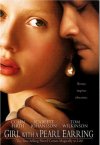BUY THE DVD:
|


|
|
|
SYNOPSIS:
| |
about a peasant girl who worked in johannes vermeer's home, and how she eventually inspired the painter's most famous work.
|
|
|
MOVIE FACT:
| |
won the golden hitchcock, audience award at the 2003 dinard festival of british cinema.
|
|
|
RATING:
|




four out of four possible stars
|
|
|
|
It is rare that a film that is can exist on a successful level when little to no dialogue exists in many of the scenes and there seems to be more "style" than substance on the screen. But part of what Girl With A Pearl Earring conveys is the filmmakers' obvious appreciation for painting and art as every single frame of the film looks as if it could have been painted by one of Rembrandt van Rijn contemporaries. Johannes Vermeer, the painter of "Girl With A Pearl Earring," the seventeenth century work of art upon which author Tracy Chevalier's novel was based, isn't the focus of the story though.
The mysterious girl in the painting, an unknown person in history, but given an identity in Chevalier's novel as "Griet," a servant girl in the Vermeer household. Played with an endless amount of depth and insight by Scarlett Johansson, a young actress who has scarcely any lines in the film yet who easily communicates to the audience exactly what her character is thinking and feeling. Intelligent dramatic timing has much to do with it, but Johansson has a natural screen presence that just begs the viewer to keep his or her eyes glued to the screen. Such wisdom in an actor under the age of twenty is rare, and when someone performs with such sagacity, it doesn't seem to matter what number of words that come out of her mouth over the course of the rather short film.
It's almost as if screenwriter Olivia Hetreed, in using Chevalier's novel, took the idea that a painting is solely a visual medium, to adapt the dialogue and the story. The influence of director Peter Webber obviously exists as well, as the performances from the lead actors could not have come simply from the script, given that the number of lines of dialogue in a normal film just doesn't appear in this one. It doesn't seem as though the dialogue was edited out either, because there are many times when the characters are on the screen for at least a minute, saying nothing at all.
And on that note, it seems worth pointing out that without those long silences where characters interact yet use no dialogue to sustain the narrative, allow the film to just sail past the usual feature film minimum of a ninety minute running time. Had the movie been edited with quick cuts and energetic cinematography, the film could have concluded in about a half an hour. But director of photography Eduardo Serra can lay claim to one of the most impressive aspects of the film, as his composition certainly takes advantage of the 2.35:1 aspect ratio. It's almost like he and the production design crew studied Vermeer and others' paintings of the era to create the look of the film.
The effort put forth in creating a realistic portrayal of the seventeenth century Netherlands (though the film was shot in Luxembourg) is wholly evident from the intense detail present in all of the set design and costuming. Simply put, the film is beautiful in every scene, even when the narrative is dark and the characters are troubled. Even during the climactic scene near the end where Vermeer's wife (played deliciously by Essie Davis), the set design is subtly elegant and stark, never intruding on the importance of the characters, but never lagging in its dark and sultry appeal.
Playing Vermeer himself, the enigmatic Colin Firth injects a welcome amount of levity into his role, despite the serious nature of the picture. In using Johansson's character as his muse, Firth might even have fewer words of dialogue, but his presence is no less compelling. The increasingly prolific Tom Wilkinson (he currently has five films in some aspect of production) plays Vermeer's benefactor, "Van Ruijven," and is a stormy yet welcome presence in the languorous film. The striking Cillian Murphy plays "Pieter," a butcher's assistant who courts Griet throughout the film, and his nearly gaunt-like face is at odds with his warm character.
Something that viewers should be aware of when they view this film is that it's not a "slow moving" film. Though the camera movements are languid and fluid and the characters definitely take their time in expressing their feelings, the story rolls along at an acceptable pace, never allowing the film to sag. Perhaps it's the beauty of the cinematography or maybe it's the intense performances from each of the actors, but it's difficult to take your eyes off the screen once the film has begun. The fact that it runs for such a short ninety minutes (how many historical films have been close to an hour longer or more?) might be its saving grace.
Review by Kelsey Wyatt.
| |
|